Skip to content 
BOOKS FOR KIDS: GREAT DEPRESSION
Born and Bred in the Great Depression
By Jonah Winter, Illustrated by Kimberly Bulchen Root
East Texas, the 1930s — the Great Depression: Award-winning author Jonah Winter’s father grew up with seven siblings in a tiny house on the edge of town. Winter shares his father’s story in a lyrical text that is a celebration of family and making do with what you have. 5-9 years

Ruby’s Hope: The Story of How the Famous “Migrant Mother” Photograph Became the Face of the Great Depression
By Monica Kulling, Illustrated by Sara Dvojack
Dorothea Lange’s Depression-era “Migrant Mother” photograph is an icon of American history. Behind this renowned portrait is the story of a family struggling against all odds to survive.
Dust storms and dismal farming conditions force young Ruby’s family to leave their home in Oklahoma and travel to California to find work. As they move from camp to camp, Ruby sometimes finds it hard to hold on to hope. But on one fateful day, Dorothea Lange arrives with her camera and takes six photographs of the young family. When one of the photographs appears in the newspaper, it opens the country’s eyes to the reality of the migrant workers’ plight and inspires an outpouring of much needed support.

Children of the Great Depression
By Russell Freedman
Russell Freedman illuminates the lives of the American children affected by the economic and social changes of the Great Depression. Middle-class urban youth, migrant farm laborers, boxcar kids, children whose families found themselves struggling for survival…all Depression-era young people faced challenges like unemployed and demoralized parents, inadequate food and shelter, schools they couldn’t attend because they had to go to work, schools that simply closed their doors. Even so, life had its bright spots — like favorite games and radio shows — and many young people remained upbeat and optimistic about the future.
Drawing on memoirs, diaries, letters and other firsthand accounts, and illustrated with classic archival photographs, this book by one of the most celebrated authors of nonfiction for children places the Great Depression in context and shows young readers its human face. 10-12 years

What Was the Great Depression?
By Janet B. Pascal, Illustrated by Dede Putra
On October 29, 1929, life in the United States took a turn for the worst. The stock market — system that controls money in America — plunged to a record law. But this event was only the beginning of many bad years to come. By the early 1930s, one out of three people was not working. People lost their jobs, their houses, or both and ended up in shantytowns called “Hoovervilles” named for the president at the time of the crash. By 1933, many banks had gone under. Though the United States has seen other times of struggle, the Great Depression remains one of the hardest and most widespread tragedies in American history. 8-12 years

Dorothea Lange: The Photographer Who Found the Faces of the Depression
By Carole Boston Weatherford, Illustrated by Sarah Green
Before she raised her lens to take her most iconic photo, Dorothea Lange took photos of the downtrodden, from bankers in once-fine suits waiting in breadlines, to former slaves, to the homeless sleeping on sidewalks. A case of polio had left her with a limp and sympathetic to those less fortunate. Traveling across the United States, documenting with her camera and her fieldbook those most affected by the stock market crash, she found the face of the Great Depression. 5-8 years

Children of the Dust Bowl: The True Story of the School at Weedpatch Camp
By Jerry Stanley
Illustrated with photographs from the Dust Bowl era. This true story takes place at the emergency farm-labor camp immortalized in Steinbeck’s The Grapes of Wrath. Ostracized as “dumb Okies,” the children of Dust Bowl migrant laborers go without school — until Superintendent Leo Hart and 50 Okie kids build their own school in a nearby field. 8-12 years

Potato: A Tale From the Great Depression
By Kate Lied, Illustrated by Lisa Campbell Ernst
Kate Lied tells the story of her grandparents during the Great Depression. After her grandfather Clarence loses his job and the bank takes his house, he and his family move to Idaho to harvest potatoes. They live in a tent and earn enough money to keep the family together through hard times. 6-10 years
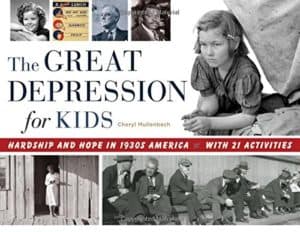
The Great Depression: Hardship and Hope in the 1930s
By Cheryl Mullenbach
Have you ever wondered what it was like to live during the Great Depression? Perhaps you think of the stock market crash of 1929, unemployed workers standing in breadlines, and dust storms swirling around the Great Plains. But the 1930s was also a time when neighbors helped neighbors, librarians delivered books by horseback, an army of young men rebuilt the nation’s forests, roads and parks, and Shirley Temple, the curly-haired child star asked moviegoers to “stand up and cheer” in the darkest days. Twenty-one hands on activities included. 9 and up

Out of the Dust
By Karen Hesse
“Dust piles up like snow across the prairie…
A terrible accident has transformed Billie Jo’s life, scarring her inside and out. Her mother is gone. Her father can’t talk about it. And the one thing that might make her feel better, playing the piano, is impossible with her wounded hands.
To make matters worse, dust storms are devastating the family farm and all the farms nearby. While others flee from the dust bowl, Billie Jo is left to find peace in the bleak landscape of Oklahoma and in the surprising landscape of her own heart. 8-12 years

Dust for Dinner
By Ann Turner, Illustrated by Robert Barrett
Jake and Maggy live on a farm where they love to sing and dance to mama’s radio. Then terrible dust storms come and ruin the land. The family has no choice but to auction off the farm and make the long hard journey west to California away from the dust storms, where the land is still green. Along the way, Papa tries to find work and Jake and Maggy try to help. But what if Papa can’t find work? What if California isn’t better after all. 4-8 years
The book descriptions used are primarily from the publishers.
If you like this post, then please consider sharing it and/or leaving a comment below! Thank you! Barbara Lowell, Children’s Author

Timeless Thomas: How Thomas Edison Changed Our Lives
By Gene Barretta
What do record players, batteries, and movie cameras have in common? All these devices were created by the man known as “The Wizard of Menlo Park,” Thomas Edison. He is most famous for inventing the incandescent light bulb. But at his landmark laboratories in Menlo Park and West Orange, New Jersey, he developed other staples of modern technology. He persevered despite many failures. We are lucky that he did because it would be very difficult to go through a day without using one of his life-changing inventions. 6-10 years

A Wizard From the Start: The Incredible Boyhood and Amazing Inventions of Thomas Edison
By Don Brown
A wizard from the start, Thomas Edison had a thirst for knowledge, taste for mischief, and hunger for discovery—but his success was made possible by his boundless energy. At age fourteen he coined his personal motto: “The More to do, the more to be done,” and then went out and did: picking up skills and knowledge at every turn. When learning about things that existed wasn’t enough, he dreamed up new inventions to improve the world. From humble beginnings as a farmer’s son, selling newspapers on trains and reading through public libraries shelf by shelf, Tom began his inventing career as a boy and became a legend as a man. 4-7 years

When Thomas Edison Fed Someone Worms
By Mark Andrew Weakland, Illustrated by Thomas Radcliffe
Thomas Edison became a great American inventor and businessman. But do you know what he was like as a child? From exploring shipyards and pastures to feeding a girl worms, Thomas was a curious and creative child. This playful story of his childhood will help young readers connect with a historic figure and will inspire them to want to achieve greatness. 6-8 years

The Unexpected Light of Thomas Alva Edison
By Raymond Arroyo, Illustrated by Kristina Gehrmann
No one thought much of young Thomas Alva Edison. He couldn’t focus at school and caused trouble around the house. But where others saw a distracted and mischievous boy, his mother saw imagination and curiosity. At only seven years old, Al, as he was called as a young child, was educated by his mother, who oversaw his rigorous at-home education while also allowing him great freedom to explore and dream. Those early years of encouragement and loving guidance formed the man who would apply those valuable lessons as well as his rich imagination to inventing the phonograph, the motion picture camera, the light bulb, and more. 4-8 years

Thomas Edison and His Bright Idea
By Patricia Brennan Demuth, Illustrated by Jez Tuya
This nonfiction reader shines a light on Thomas Edison and his greatest invention — the light bulb! As a curious child who was always asking questions, it’s no wonder he grew up to become a famous, prolific inventor. This story follows Edison from his time in school to his career as full-time inventor. His discoveries will fascinate and inspire all curious young minds. 6-8 years
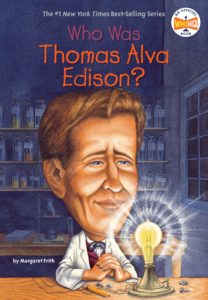
Who Was Thomas Edison?
By Margaret Frith, Illustrated by John O’Brien
One day in 1882, Thomas Edison flipped a switch that lit up lower Manhattan with incandescent light and changed the way people lived. The electric light bulb was only one of thousands of Edison’s inventions. As a boy, observing a robin catch a worm and then take flight, he fed a playmate a mixture of worms and water to see if she could fly. 8-12 years

Thomas Edison Lighting the Way
By Lori Haskins Houran, Illustrated by Gustavo Mazali
Most people today know Thomas Edison as the inventor of the light bulb—except, he isn’t! In Edison’s time, other inventors were working on the light bulb, but no one could figure out how to keep the light bulb lit. This is where Edison came in. Read and find out all about the real story of Thomas Edison’s life and his many amazing inventions, like the movie camera and the battery for an electric car! Biography reader includes a timeline and historical photos all about the life of this inspiring figure. 4-8 years
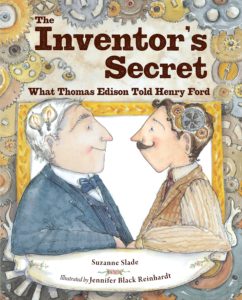
The Inventor’s Secret: What Thomas Edison Told Henry Ford
By Suzanne Slade, Illustrated Jennifer Black Reinhardt
Thomas Edison and Henry Ford started off as insatiably curious tinkerers. That curiosity led them to become inventors — with very different results. As Edison invented hit after commercial hit, gaining fame and fortune, Henry struggled to make a single invention, an affordable car, work. Witnessing Thomas’s glorious career from afar, a frustrated Henry wondered about the secret to his success. This little-known story is a fresh, kid-friendly way to show how they grew up to be the most famous inventors in the world and best friends, too. 6-9 years

Young Thomas Edison
By Michael Dooling
How did Thomas Edison grow up to be America’s greatest inventor? This book explores the beginnings of his genius from his difficulty in school, to his early years as a young scientist, to the man everyone called, “The Wizard of Menlo Park.” 7 and up
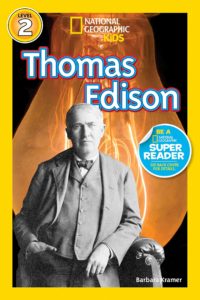
National Geographic Readers: Thomas Edison
By Barbara Kramer
Learn all about Thomas Edison, one of the most important figures in American history, in this leveled reader written in an easy-to-grasp style that will encourage the inventors of tomorrow! 5-8 years
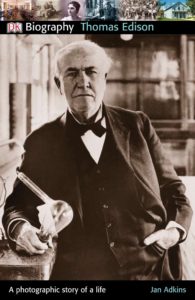
DK Biography Thomas Edison: A Photographic Story of a Life
By Jan Adkins
Filled with archival photographs and amazing facts, this biography tells the story of the famous inventor, from his childhood as an “addled” student, to his reign as the “Wizard of Menlo Park,” where he developed the electric light bulb, the phonograph, and many other inventions still in use today. 10-17 years
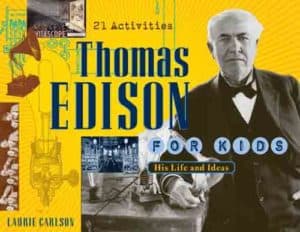
Thomas Edison For Kids: His Life and Ideas, 21 Activities
By Laurie Carlson
Thomas Edison, one of the world’s greatest inventors, is introduced in this activity books. Children will learn how he ushered in an astounding age of invention with his unique way of looking at things and his refusal to be satisfied with only one solution to a problem. This books helps to inspire kids to be inventors and scientists, as well as persevere with their own ideas. Activities allow children to try Edison’s experiments: making a puppet dance, using static electricity, manufacturing a switch for an electric current, constructing a telegraph machine, and many more. 9-12 years.
The book descriptions used are primarily from the publishers.
If you like this post, then please consider sharing it and leaving a comment below. Thank you! Barbara Lowell, Children’s Author

Satchmo’s Blues
By Alan Schroeder, Illustrated by Floyd Cooper
On hot summer nights in New Orleans, a boy named Louis Armstrong would peek under the big swinging doors of Economy Hall and listen to the jazz band. The best night was Friday, when Bunk Johnson would blow his cornet till the roof trembled. At moments like those, Louis could feel his toes tingle. He wanted to be like Bunk Johnson; aim his horn straight up at the night sky and set the stars spinning.
One day Louis saw a horn in a pawnshop window — a real brass cornet. The cardboard sign said $5.00. How could he ever come up with that much money? Every day Louis did what he could to earn that five dollars, and every day he practiced blowing his imaginary horn. It was a dream he would never give up. Louis Armstrong’s dynamic personality and amazing trumpet playing would cast a spell on millions of people around the world, to whom he will always be the one and only Satchmo, the Ambassador of Jazz. 3-7 years

Just a Lucky So and So
By Lesa Cline-Ransome, Illustrated by James E. Ransome
Louis Armstrong has been called the most important improviser in the history of jazz. Although his New Orleans neighborhood was poor in nearly everything, it was rich in superb music. Young Louis took it all in, especially the cornet blowing of Joe “King” Oliver. But after a run-in with the police, eleven-year-old Louis was sent away to the Colored Waif’s Home for Boys where he became a disciplined musician in the school’s revered marching band. Ultimately, he was to travel the world and transform jazz through his improvised singing (scatting) and masterful trumpet playing. 6-9 years
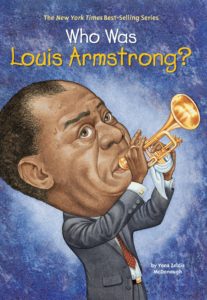
Who Was Louis Armstrong?
By Yona Zeldis McDonough, Illustrated by John O’Brien
If not for a stint in reform school, young Louis Armstrong might never have become a musician. It was a teacher at the Colored Waifs Home for Boys who gave him a cornet and saw talent in the kid from the tough New Orleans neighborhood called Storyville. But it was Louis’s own passion and genius that pushed jazz into a new and exciting direction with his amazing, improvisational trumpet playing. 8-12 years

A Horn for Louis: Louis Armstrong as a Kid
By Eric A. Kimmel, Illustrated by James Bernardin
How did famous New Orleans jazz trumpet player Louis Armstrong get his first horn? Seven-year-old Louis was too poor to buy a real instrument. He didn’t even go to school. To help his mother pay the rent, every day he rode a junk wagon through the streets of New Orleans, playing a tin horn and collecting stuff people didn’t want. One day, he passed a pawn shop with a gleaming brass trumpet in the window… 7-10 years
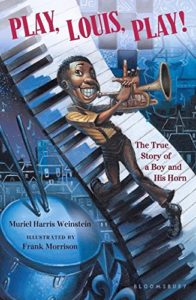
Play, Louis, Play! The Story of a Boy and His Horn
By Muriel Harris Weinstein, Illustrated by Frank Morrision
The childhood of Louis Armstrong was as fascinating as the great musician himself. This chapter book biography is written from the point of view of Louis’s closest companion throughout his youth: his horn! In an exuberant voice, this unusual narrator tells Louis’s story beginning with the small New Orleans hock shop where he bought his first trumpet for five hard-earned dollars. He goes from a street quartet to the marching band of the Colored Waif’s Home to the big sounds of New Orleans. 7-10 years
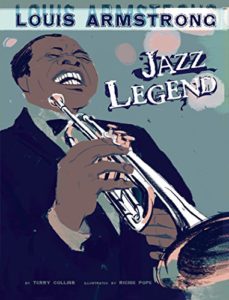
Louis Armstrong Jazz Legend
By Terry Collins, Illustrated by Richie Pope
Louis Armstrong, also known as Satchmo and Pops, became an American jazz legend in the 1920s. His voice and skill with instruments helped him become a popular musician in the racially divided country. Watch as this skilled musician learns to play, buys his first instrument, and becomes one of the best music makers ever. 8-14 years
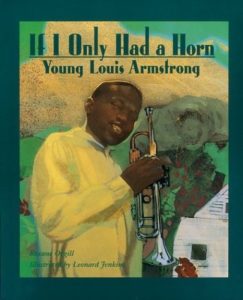
If I Only Had a Horn: Young Louis Armstrong
By Roxanne Orgill, Illustrated by Leonard Jenkins
This book tells the story of Louis Armstrong who grew up to be a giant of jazz. As a poor boy in New Orleans, where music was everywhere, he longed to play a horn. 9-12 years
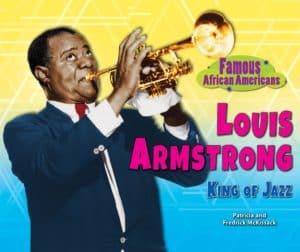
Louis Armstrong: King of Jazz
By Patricia and Frederick McKissack
“Music has been in my blood from the day I was born,” Louis Armstrong said. He rose from a troubled childhood and a life of poverty to set the music world on fire. Armstrong’s lively trumpet playing, trademark “scat” singing, and natural talent for showmanship dazzled audiences for more than fifty years. 6-9 years
The book descriptions used are primarily from the publishers.
If you like this post, then please consider sharing it and leaving a comment below. Thank you! Barbara Lowell, Children’s Author

Moses: When Harriet Tubman Let Her People to Freedom
By Carole Boston Weatherford, Illustrated by Kadir Nelson
This poetic book is a resounding tribute to Tubman’s strength, humility, and devotion. With proper reverence, Weatherford and Nelson do justice to the woman who, long ago, earned the name Moses. 5-8 years
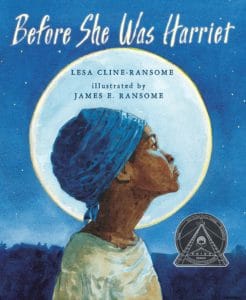
Before She Was Harriet
By Lesa Cline-Ransome, Illustrated by James E. Ransome
We know her today as Harriet Tubman, but in her lifetime she was called many names. As General Tubman, she was a Union spy. As Moses, she led hundreds to freedom on the Underground Railroad. As Minty, she was a slave whose spirit could not be broken. And as Araminta, she was a young girl whose father showed her the stars and the first steps on the path to freedom.
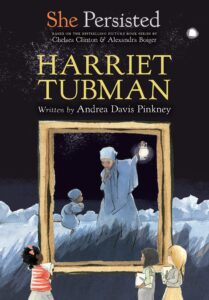
She Persisted: Harriet Tubman
By Andrea Davis Pinkney, Illustrated by Alexandra Boiger and Gillian Flint
Born enslaved, Harriet Tubman rose up to become one of the most successful, determined and well-known conductors of the Underground Railroad. With her family’s love planted firmly in her heart, Harriet looked to the North Star for guidance–and its light helped guide her way out of slavery. Her courage made it possible for her to help others reach freedom too.
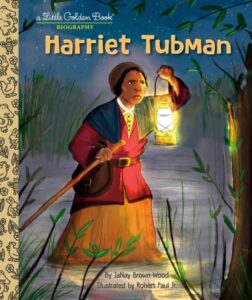
Harriet Tubman: A Little Golden Book Biography
By JaNay Brown-Wood, Illustrated by Robert Paul, Jr.
Inspire and educate your little one with this Little Golden Book biography. It’s the perfect introduction to nonfiction for preschoolers. This Little Golden Book tells the story of a true hero who helped to free enslaved Black people as a conductor on the Underground Railroad.

Harriet Tubman Conductor on the Underground Railroad
By Ann Petry
Harriet Tubman: Conductor on the Underground Railroad was praised by the New Yorker as “an evocative portrait,” and by the Chicago Tribune as “superb.” It is a gripping and accessible portrait of the heroic woman who guided more than 300 enslaved people to freedom.
She was born in slavery and dreamed of being free. She was willing to risk everything—including her own life—to see that dream come true. After her daring escape, Harriet became a conductor on the secret Underground Railroad, helping others make the dangerous journey to freedom.

Escape North! The Story of Harriet Tubman
By Monica Kulling, Illustrated by Teresa Flavin
This book is an easy-to-read page-turning account of Harriet Tubman’s life. It follows her childhood in slavery, to her years as a conductor on the Underground Railroad, to her later work as a suffragette and as a spy in the Civil War. This remarkable true story brings to life one of America’s greatest female role models.
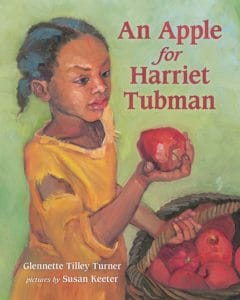
An Apple For Harriet Tubman
By Glennette Tilley Turner, Illustrated by Susan Keeter
Like other enslaved African American children, young Harriet Tubman had to work hard. She spent long hours in her master’s orchard picking the juicy apples she was forbidden to eat. Harriet vowed to one day be free and grow apple trees of her own. As an adult, she made her escape to the North. She then repeatedly returned south, risking her life, to lead slaves to freedom.

Who Was Harriet Tubman?
By Yona Zeldis McDonough, Illustrated by Nancy Harrison
Born a slave in Maryland, Harriet Tubman knew first-hand what it meant to be someone’s property. She was whipped by owners and almost killed by an overseer. It was from other field hands that she heard about the Underground Railroad. After her escape to Philadelphia, she returned to the South again and again to help slaves escape to freedom.

Minty: A Story of Young Harriet Tubman
By Alan Schroeder, Illustrated by Jerry Pinkney
They called her “Minty.” When she grew up, she became known as Harriet Tubman. She was the courageous and heroic woman who helped hundreds of slaves escape to freedom through the Underground Railroad. But she was a little girl once too. Minty, short for Araminta, was a headstrong young slave whose rebellious spirit often got her into trouble. When her father taught her the skills necessary to escape, she listened carefully and learned what to do.

The Story of Harriet Tubman: A Biography For New Readers
By Christine Platt
Discover the life of Harriet Tubman―a story about courage, bravery, and freedom
Harriet Tubman became a celebrated leader in the fight to free people from slavery. Before that, she was a determined young girl who believed that everyone deserved to be free. Harriet Tubman bravely used the Underground Railroad―a network of secret routes and safe houses―to free herself and many other enslaved people. Explore how Harriet Tubman went from being a slave on a plantation in Maryland to one of the most important figures in American history. How will her courageous spirit inspire you?
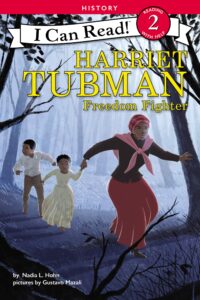
Harriet Tubman Freedom Fighter
By Nadia L. Hohn, Illustrated by Gustavo Mazali
Harriet Tubman was a brave woman who was born enslaved in Maryland in the 1800s. After risking everything to escape from her slave master and be free, she went on to lead many people to freedom on a journey known today as the Underground Railroad.
This book covers some of the amazing aspects of her life: She led 13 escapes—all successful and at great personal risk—between 1850 and 1860. This book also covers some of the lesser-known amazing aspects of her life: During the Civil War, Harriet Tubman enlisted African American men to be soldiers. She served as a spy and led a battle under the command of a Union Army colonel!
Beginning readers will learn about the milestones in Harriet Tubman’s life in this Level Two I Can Read biography. This biography includes a timeline and historical illustrations all about the life of this inspiring figure, as well as a rare historical photograph of her. Much mythology and conflicting lore exists about Harriet Tubman. This book was carefully vetted by noted expert Dr. Kate Larson.

When Harriet Met Sojourner
By Catherine Clinton, Illustrated by Shane W. Evans
Two women with similar backgrounds. Both slaves and both fiercely independent. Both great women in different ways. Harriet Tubman was the brave pioneer who led her fellow slaves to freedom. Sojourner Truth was a strong woman who spoke up for African American rights. One day in 1864, the lives of these two women came together.

DK Biography: Harriet Tubman
By Kem Knapp Sawyer
Harriet Tubman tells the story of the famous abolitionist, from her childhood as a slave on a Maryland plantation, to her dramatic escape, to her tireless work as an organizer of the Underground Railroad. This book is full of archival photographs and amazing facts.
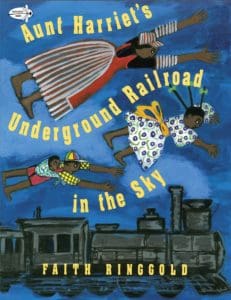
Aunt Harriet’s Underground Railroad in the Sky
By Faith Ringgold
Cassie and her brother Be Be meet a train full of people. Be Be joins them. The train departs before Cassie can climb aboard. With Harriet Tubman as her guide, Cassie retraces the steps escaping slaves took on the real Underground Railroad and is reunited with her brother.
The book descriptions used are primarily from the publishers.
If you like this post, then please consider sharing it and leaving a comment below. Thank you! Barbara Lowell, Children’s Author
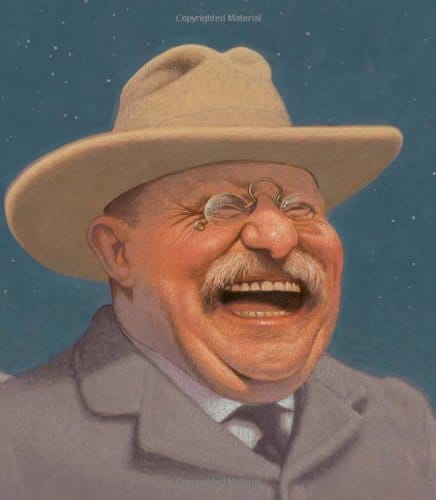
To Dare Mighty Things: The Life of Theodore Roosevelt
By Doreen Rappaport, Illustrated by C.F. Payne
President Theodore Roosevelt is known as “the man with a plan,” and the “rough rider.” His figure stands tall in American history. And his legacy stretches him to larger-than-life proportions. But before his rise to fame, he was just “Teedie,” a boy with ambitious dreams to change the world, and the conviction to see his stupendous imaginings brought to fruition.
As an American president, he left an impressive mark upon his country. He promised a “square deal” to all citizens, he tamed big businesses, and protected the nation’s wildlife and natural beauty. His fearless leadership assured that he would always be remembered, and his robust spirit now dares others to do mighty things. 6 and up

A Fine Little Bad Boy: Quentin Roosevelt in the White House
By Barbara Lowell, Illustrated by Antonio Marinoni
Based on the true escapades of Quentin Roosevelt, this bighearted picture book is about a boy full of mischief who craves his famous father’s attention.
Quentin may be the “littlest Roosevelt,” but he soon rivals his father, the famous Teddy, as the biggest personality in the White House of the early 1900’s. From roller skating in the halls to shooting spitballs at Andrew Jackson’s portrait. From swimming in the fountains to taking a pony for an elevator ride. This “fine little bad boy” takes full advantage of his father’s long tenure as president, believing the good times will never end. 4-8 years

You’re on Your Way, Teddy Roosevelt
By Judith St. George, Illustrated by Matt Faulkner
Before Teddy Roosevelt became famous as a statesman, naturalist, colonel in the Spanish-American War, and twenty-sixth president of the United States, he was a young boy called “Teedie” who struggled with terrible asthma. Overcoming his illness was a major battle in his young life. With determination to make himself strong and healthy, he set the course for his amazing accomplishments to come. 5-9 years
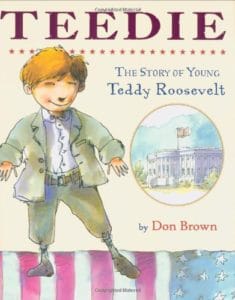
Teedie: The Story of Young Teddy Roosevelt
By Don Brown
Teedie was not exactly the stuff of greatness: he was small for his size. Delicate. Timid. Nervous. By the time he was ten years old he had a frail body and weak eyes. He was deviled by asthma, tormented by bullies. His favorite place to be was at home. Some may think that because of these things, Teedie was destined for a ho-hum life. But they would be wrong. For Teedie had a strong mind, as well as endless curiosity and determination. Is that all? No. Teedie had ideas of his own — lots of them. It wasn’t long before the world knew him as Theodore Roosevelt, the youngest president of the United States. 4-7 years

Teddy Roosevelt Was a Moose?
By Dan Gutman, Illustrated by Allison Steinfeld
Did you know that Theodore Roosevelt was shot before a rally, and went on to give his speech with the bullet in his chest? Or that he skinny-dipped in the Potomac River? Bet you didn’t know that he had a zebra, a lion, and a one-legged rooster at the White House! Siblings Paige and Turner have collected some of the most unusual and surprising facts about the larger-than-life president, from his childhood and his Rough Rider days to his rise to politics and his complicated presidential legacy. 6-8 years
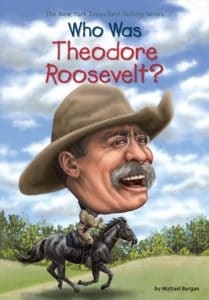
Who Was Teddy Roosevelt?
By Michael Burgan, Illustrated by Jerry Hoare
He was only 42 years old when he was sworn in as president of the United States in 1901 — making him the youngest president ever. He was also the first sitting president to win the Nobel Peace Prize, to ride in a car, and to fly in an airplane. Theodore Roosevelt’s achievements as a naturalist, explorer, author, and soldier are as much a part of his fame as any office he held as a politician. 8-12 years
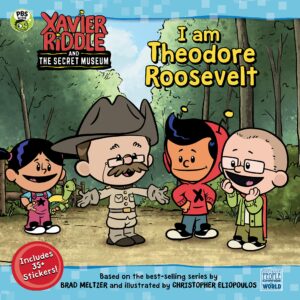
I Am Theodore Roosevelt
By Brooke Vitale
Based on the children’s book series Ordinary People Change the World by New York Times bestselling author Brad Meltzer and illustrator Christopher Eliopoulos, the series will introduce kids to inspiring historical figures and the character virtues that helped them succeed.
Brad does not like creepy crawly things and has marked the entire playground as a No-Go Zone! The Secret Museum sends him, Xavier, and Yadina to meet Theodore Roosevelt who helps them learn that creepy crawly things need space to live, too. 3-5 years
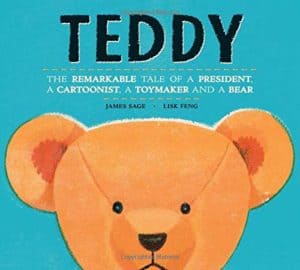
Teddy! The Remarkable Tale of a President, a Cartoonist, a Toymaker, and a Bear
By James Sage, Illustrated by Lisk Feng
James Sage uses a playful blend of fact and fiction to tell this entertaining tale. The story goes that on a hunting trip in 1902, President Theodore “Teddy” Roosevelt refused to shoot a bear. “Me? Shoot that little fellow?” he said. “Why, if I so much as ruffled his fur, I’d never be able to look my children in the eyes again!” When a political cartoonist shared the story in the newspaper, New York shopkeepers Rosie and Morris Michtom were impressed by the president’s big, warm heart. So, they decided to create a Teddy bear in his honor to sell in their store. The bear was so popular, they made another one. And another. Before they knew it, they had to build a factory to accommodate the demand. It seemed every child wanted a teddy bear of their own! 4-8 years
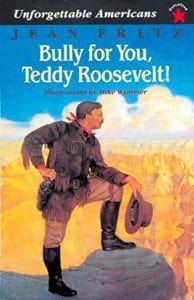
Bully For You Teddy Roosevelt
By Jean Fritz, Illustrated by Mike Wimmer
Newbery Honor-winning author and preeminent biographer for young people, Jean Fritz, brings to life our colorful 26th president. Conservationist, hunter, family man, and politician, Teddy Roosevelt commanded the respect and admiration of many who marveled at his energy, drive and achievements. 8-12 years
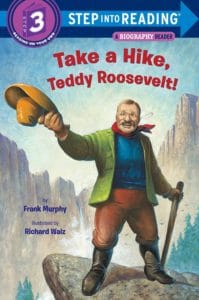
Take a Hike, Teddy Roosevelt
By Frank Murphy, Illustrated by Richard Walz
A Step 3 Step into Reading Biography Reader about Theodore Roosevelt, America’s 26th president — and his efforts to protect our environment and establish national parks. Roosevelt battled asthma all his life, and the list of things he shouldn’t do was long. But when people told him “you can’t” he set about proving them wrong. This book focuses on his inexhaustible enthusiasm and his commitment to preserving America’s natural resources. 5-8 years
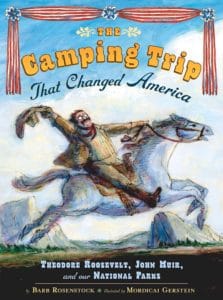
The Camping Trip That Changed America
By Barb Rosenstock, Illustrated by Mordicai Gerstein
Caldecott medalist Mordicai Gerstein captures the majestic redwoods of Yosemite in this little-known but important story from our nation’s history. In 1903, President Theodore Roosevelt joined naturalist John Muir on a trip to Yosemite. Camping by themselves in the uncharted woods, the two men saw sights and and held discussions that would ultimately lead to the establishment of our national parks. 6-9 years

What to do About Alice?
By Barbara Kerley, Illustrated by Edwin Fotheringham
Theodore Roosevelt had a small problem. Her name was Alice. Alice Lee Roosevelt was hungry to go places, meet people, do things. Father called it running riot. Alice called it eating up the world. Whether she was entertaining important White House visitors with her pet snake or traveling the globe, Alice bucked convention and turned every new experience into an adventure! Brimming with affection and wit, this spirited biography gives readers a peek at family life inside the White House. 7-10 years
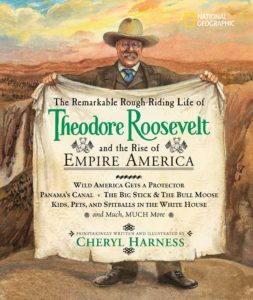
The Remarkable Rough-Riding Life of Theodore Roosevelt
and the Rise of Empire America
By Cheryl Harness
How did a sickly boy transform himself into one of the country’s boldest leaders? Through the lively narrative and engaging artwork, readers will see Teddy riding the range in South Dakota, charging up San Juan Hill in the Spanish-America War, and climbing the political ladder all the way to the White House. 8-12 years

Being Teddy Roosevelt, a Boy, A President, and a Plan
By Claudia Mills, Illustrated by R.W. Alley
Riley O’Rourke is writing his report on President Teddy Roosevelt in preparation for the fourth grade biography tea. But he has a far more important goal: to get a saxophone so he can take instrumental music. His mother can’t afford to rent a sax. He’s sure he’ll never save up enough money to buy one. But as Riley learns more about Roosevelt’s “bully” spirit, he realizes that there just might be a way to solve his problem after all. 7-10 years
The book descriptions used are primarily from the publishers.
If you like this post, then please consider sharing it and leaving a comment below. Thank you! Barbara Lowell, Children’s Author
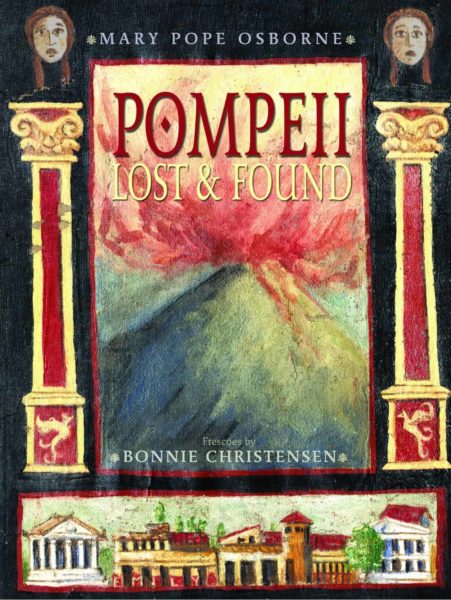
Pompeii Lost and Found
By Mary Pope Osborne, Illustrated by Bonnie Christensen
The famous eruption of Mount Vesuvius that ended life in Pompeii and buried the town has long been a fascinating moment in history for children. This book presents that dramatic story with brief text and stunning frescoes using the same colors, style, and technique as the ancient frescoes unearthed there. In addition to the destruction of the city and the rediscovery of the ruins nearly 1,700 years later, this book shows what daily life was like in this prosperous Roman town in the year 79 A.D.
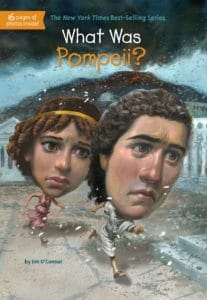
What Was Pompeii?
By Jim O’Connor, Illustrated by John Hinderliter
The morning of August 24, A.D. 79, seemed like any other in the Roman city of Pompeii. So, no one was prepared when the nearby volcano Mount Vesuvius suddenly erupted, spouting ash that buried the city and its inhabitants. The disaster left thousands dead, and the city was no more than a memory for almost 1,700 years. In 1748, explorers rediscovered Pompeii with intact buildings and beautiful mosaics. This easy-to-read account is gripping and includes photos of the ruins.

Escape From Pompeii
By Christina Balit
Tranio, like most Roman boys, likes to watch whatever is going on: tradesmen selling their goods, ships unloading their exotic cargoes, politicians making speeches in the forum. But one hot August day a very different scene unfolds. The ground begins to shake, the sky to darken. People run gasping for air. Heading for the harbor. Tranio and his friend Livia hide on a boat and witness one of the most terrifying moments in recorded history — the eruption of Mount Vesuvius and the destruction of their beloved city, Pompeii.
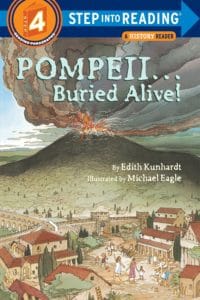
Pompeii Buried Alive
By Edith Kunhardt, Illustrated by Michael Eagle
A Step 4 history reader, “The drama of natural disasters provides prime material to entice young independent readers. In this book, the account of the eruption of Mount Vesuvius describes village life 2,000 years ago, the eruption itself and its aftermath, and the excitement when the buried town is rediscovered centuries later — Publishers Weekly
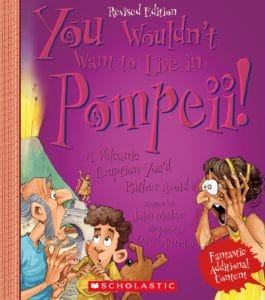
You Wouldn’t Want to Live in Pompeii
By John Malam, Illustrated by David Antram
Get ready…as a trusted slave in a quiet Roman town in 79 CE, you’re about to undergo the most terrifying experience of your life. You’ll never forget what its like to live in Pompeii. Find out all about the horrible fate of the residents, what remains of the town today, and how Vesuvius’s victims were preserved for eternity.
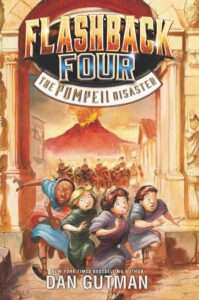
The Pompeii Disaster
By Dan Gutman
Eccentric billionaire Miss Z is sending Luke, Julia, David, and Isabel on another mission back in time to capture one of history’s most important events.
This time, the Flashback Four are headed to AD 79 to photograph the eruption of Mount Vesuvius! Can the Flashback Four get their photo and get back home before they become ancient history?
With real photographs from Pompeii to help put young readers right in the action, plus back matter that separates fact from fiction, The Pompeii Disaster tells the story of one of the world’s most devastating natural disasters like you’ve never seen it before.
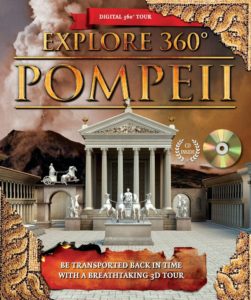
Explore 360° Pompeii: Be Transported Back in Time With Breathtaking 3D Tour
By Peter Crisp and Dr. Hannah Platts
More than 1,900 years ago, the Roman city of Pompeii was frozen in time when the massive eruption of Mt. Vesuvius buried the city, and everyone in it, under layers of ash. Millions are gripped by this dramatic story of the sudden destruction of the town, and the fascinating preservation of the people and animals who were there when it happened. This book offers an in-depth look at life there before, during, and after the eruption.

Pompeii
By Peter Connolly
This book is a comprehensive look at the ancient city of Pompeii that begins with scientific facts: How was it destroyed? How did Mount Vesuvius become an active volcano? What happened during the eruption? How long did Pompeii lay buried and how was it finally rediscovered? What was its history before the disaster? The author rebuilds the past in words and pictures, allowing us to imagine what it was like to live in old Pompeii. Like an archaeological detective, he sifts through the ruins and artifacts to reconstruct one area of the town in minute detail.

Bodies From the Ash: Life and Death in Ancient Pompeii
By James M. Deem
In ancient times, Pompeii was one of the largest cities in the Roman Empire. Its 20,000 inhabitants lived in the shadow of Vesuvius, which they believed was nothing more than a mountain. But Vesuvius was a volcano. And on the morning of August 24, A.D. 79, Vesuvius began to erupt. Within twenty-four hours, the entire city and many of its citizens had been utterly annihilated. It was not until hundreds of years later that Pompeii saw daylight again as archaeological excavations began to unearth what had been buried under layers of volcanic rubble. Digging crews expected to find buildings and jewelry and other treasures, but they found something unexpected, too: the imprints of lost citizens, their deaths captured as if by photographic images in volcanic ash.
The book descriptions used are primarily from the publishers.
If you like this post, then please consider sharing it and leaving a comment below. Thank you! Barbara Lowell, Children’s Author
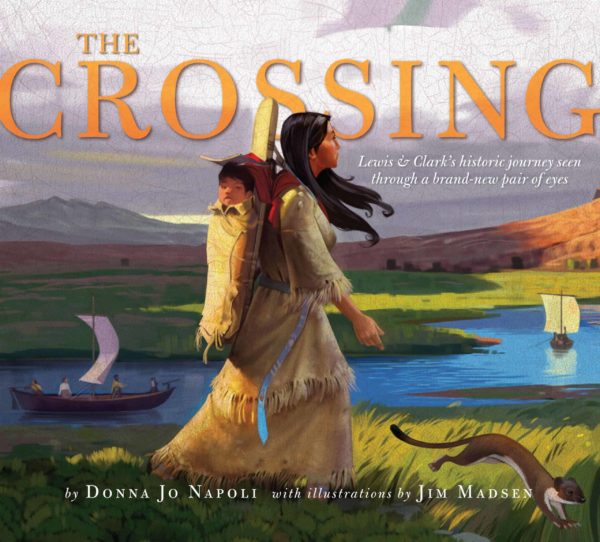
The Crossing:
Lewis & Clark’s Historic Journey Seen Through a Brand-New Pair of Eyes
By Donna Jo Napoli, Illustrated by Jim Madsen
This young, lyrical picture book reveals the adventure and natural wonders that Lewis and Clark encountered on their Western expedition in the early 1800s. Told from the point of view of Jean Baptiste Charbonneau, the baby on Sacagawea’s back, this story offers a fresh perspective of a young country and gives voice to a character that readers may be familiar with. Jean is on the Sacagawea dollar. 4-8 years

Sacagawea: Courageous Trailblazer
By James Buckley, Jr., Illustrated by Cassie Anderson
What did 33 men in the 1800s need to find their way through the wilderness on a trip across America? They needed a woman—and they found one in Sacagawea, the Native American teenage mother who helped the Lewis and Clark expedition survive. She and her baby braved floods, hunger, storms, and snakes to help the expedition that opened the West. This is the life story of an amazing pioneer who endured hardship in her youth but nevertheless became a fearless leader and a role model for generations to come. 8-12 years

How We Crossed the West
By Rosalyn Schanzer
Appealing art and descriptive text bring Lewis and Clark alive for young adventurers. Carefully chosen text from Lewis and Clark’s actual journals opens a fascinating window into this country’s exciting history. 8-12 years
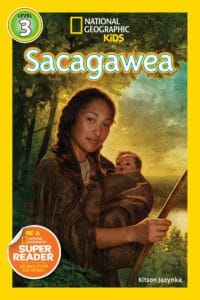
Sacagawea National Geographic Kids
By Kitson Jazynka
Explore one of the most recognized figures in American history with this biography of Sacagawea. Kids will learn about her crucial role in the Lewis and Clark expedition and her influential legacy. The level 3 text provides accessible, yet wide-ranging, information for independent readers. 6-9 years
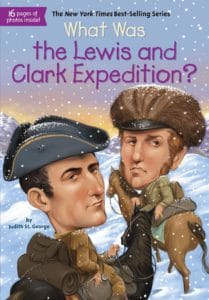
What Was the Lewis and Clark Expedition
By Judith St. George, Illustrated by Tim Foley
When Meriwether Lewis, William Clark, and the “Corps of Discovery” left St. Louis, Missouri, on May 21, 1804, their mission was to explore the vast, unknown territory acquired a year earlier in the Louisiana Purchase. The travelers hoped to find a waterway that crossed the western half of the United States. They didn’t. However, young readers will love this true-life adventure tale of the two-year journey that finally brought the explorers to the Pacific Ocean. 8-12 years

Who Was Sacagawea?
By Judith Bloom Fradin and Dennis Brindell Fradin,
Illustrated by Val Paul Taylor
Sacagawea was only sixteen when she made one of the most remarkable journeys in American history. She traveled 4,500 miles by foot, canoe, and horse, all the while carrying a baby on her back. Without her, the Lewis and Clark expedition might have failed. Through this book, kids will learn the reasons that today she is still remembered and immortalized on a golden dollar coin. 8-12 years

You Wouldn’t Want to Explore With Lewis and Clark
By Jacqueline Morley, Illustrated by Mark Bergin
It’s 1803 and two adventurous young army officers are about to lead an expedition right across the North American continent through the Rocky Mountains to the Pacific Ocean. They will explore the lands that few Europeans have ever seen and will make many scientific discoveries. Do you have what it takes to go with them? 8-12 years
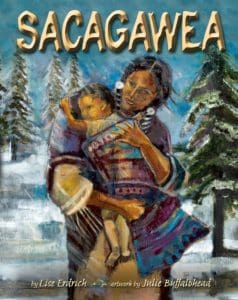
Sacagawea
By Lise Erdrich, Illustrated by Julie Buffalohead
This is a biography of the Shoshone girl, Sacagawea, from age eleven when she was kidnapped by the Hitdatsa to the end of her journey with Lewis and Clark, plus speculation about her later life. 8-12 years

Lewis and Clark: A Prairie Dog for the President
By Shirley Raye Redmond, Illustrated by John Manders
In 1803, President Thomas Jefferson sends Lewis and Clark out west to explore. He tells them to make maps. He tells them to draw pictures and collect plants. Most importantly, he tells them to send presents! What kind of present is good enough for a president? Beginning readers will enjoy reading about the fun and little-known slice of American history. 5-8 years
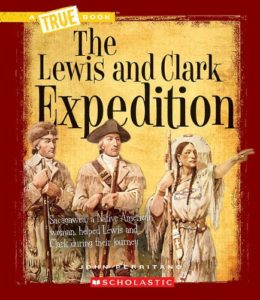
The Lewis and Clark Expedition
By John Perritano
This book takes readers on an amazing journey to a fascinating time in U.S. history. The country was experiencing dynamic change and westward expansion. Here are the important people, places and events that helped shape the western United States. 4-8 years
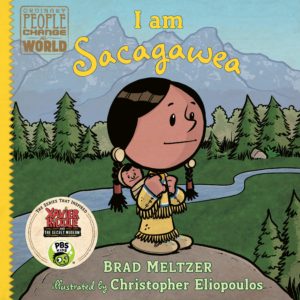
I Am Sacagawea
By Brad Meltzer, Illustrated by Christopher Elipoulos
Sacagawea was the only woman, and the only Native American, to join Lewis and Clark’s Corps of Discovery. They explored the United States from the Mississippi River all the way to the Pacific Ocean in the early 1800s. As a translator, she helped the team communicate with members of the Shoshone tribe. Traveling across the continent, she carried her child on her back. By the time the expedition arrived at the west coast, she proved that she truly was a trailblazer. 5-8 years
The book descriptions used are primarily from the publishers.
If you like this post, then please consider sharing it and leaving a comment below. Thank you! Barbara Lowell, Children’s Author
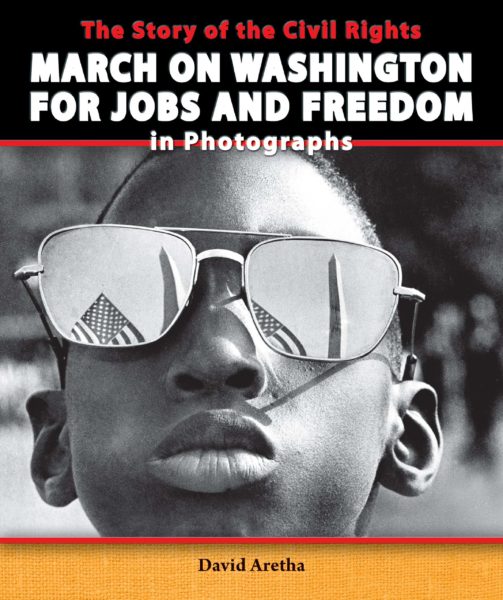
The Story of the Civil Rights March on Washington for Jobs and Freedom in Photographs
By David Aretha
On August 28, 1963, more than 250,000 people descended on Washington, D.C. They came by bus, car, and bicycle. Some even walked hundreds of miles to be there. On that day, the massive crowd gathered to march, protest, sing, and support the Civil Rights Movement and to demonstrate that the time had come to end segregation in the South. To a captivated audience, Martin Luther King, Jr., spoke of his “dream” when African Americans would have equal rights. Through primary source photographs, author David Aretha explores the “greatest demonstration for freedom” in American history. 10-13 years
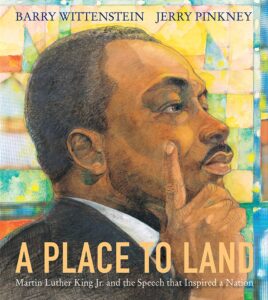
A Place to Land: Martin Luther King, Jr. and the Speech that Inspired a Nation
By Barry Wittenstein, Illustrated by Jerry Pinkney
Much has been written about Martin Luther King, Jr. and the 1963 March on Washington. But there’s little on his legendary speech and how he came to write it.
Martin Luther King, Jr. was once asked if the hardest part of preaching was knowing where to begin. No, he said. The hardest part is knowing where to end. “It’s terrible to be circling up there without a place to land.”
Finding this place to land was what Martin Luther King, Jr. struggled with, alongside advisors and fellow speech writers, in the Willard Hotel the night before the March on Washington, where he gave his historic “I Have a Dream” speech. But those famous words were never intended to be heard on that day, not even written down for that day, not even once. 7-10 years
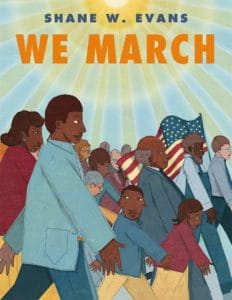
We March
By Shane W. Evans
On August 28, 1963, a remarkable event took place. More than 250,000 people gathered in our nation’s capitol to participate in the March on Washington for Jobs and Freedom. The march began at the Washington Monument and ended with a rally at the Lincoln Memorial, where Martin Luther King, Jr. delivered his historic “I Have a Dream” speech advocating racial harmony. Many words have been written about that day, but few so delicate and powerful as those presented here by author-illustrator Shane W. Evans. 4-8 years
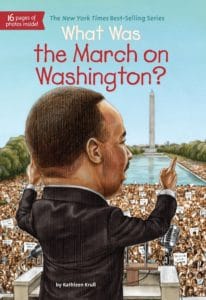
What Was the March on Washington?
By Kathleen Krull, Illustrated by Tim Tomkinson
On August 28, 1963, more than 200,000 people gathered in Washington, D.C. to demand equal rights for all races. It was there that Martin Luther King, Jr. delivered his “I Have a Dream” speech and it was this peaceful protest that spurred the momentous civil rights laws of the mid-1960s. With black and white artwork throughout and sixteen pages of photographs, the March is brought to life. 8-12 years
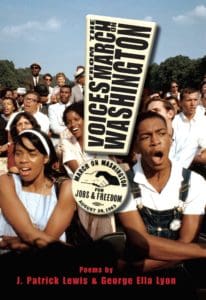
Voices From the March on Washington
By J. Patrick Lewis and George Ella Lyon
The powerful poems in this collection weave together multiple voices to tell the story of the March on Washington in 1963. From the woman singing through a terrifying bus ride to D.C., to the teenager who came partly because his father told him, “Don’t you dare go to that march,” to the young child riding above the crowd on her father’s shoulders, each voice brings a unique perspective to this tale. As the characters tell their personal stories of this historic day, their chorus plunges readers into the experience of being at the march, walking shoulder-to-shoulder with strangers hearing Martin Luther King, Jr.’s famous speech, and heading home inspired. 10-14 years

Dream March: Dr. Martin Luther King, Jr. and the March on Washington
By Vaunda Micheaux Nelson, Illustrated by Sally Wern Comport
Young readers can learn about one of the greatest civil rights leaders of all time. Dr. Martin Luther King, Jr., in this Level 3 reader. Set against Dr. King’s historic March on Washington in the summer of 1963, a moving story and powerful illustrations combine to illuminate not only one of America’s most celebrated leaders, but also one of America’s most celebrated moments. 5-8 years
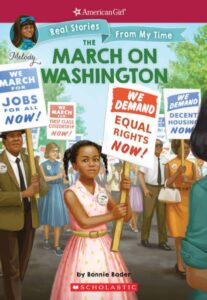
The March on Washington
By Bonnie Bader, Illustrated by Kelley McMorris
In 1963, people from all over the country came together to fight for equal rights for African Americans. The March on Washington was a peaceful protest and the setting for Martin Luther King Jr.’s “I Have a Dream” speech. But what did it take to get there? Learn about the inspiring people and incredible acts of courage that led to this historic march. Plus, American Girl Melody shares her own experiences growing up during the civil rights movement and dealing with discrimination. 7-10 years
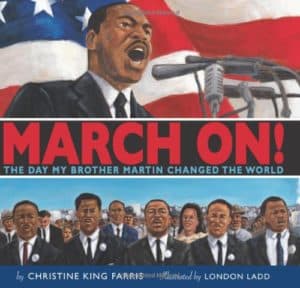
March On! The Day My Brother Martin Changed the World
By Christine King Farris, Illustrated London Ladd
From Dr. Martin Luther King’s sister, Christine, March On! is the definitive tribute to the man, the march, and the speech that changed a nation. 8-12 years

Martin Luther King, Jr. and the March on Washington
By Frances E. Ruffin, Illustrated by Stephen Marchesi
On August 28, 1963, more than 250,000 people came to the nation’s capitol. They came by plane, by bus, by car — even on roller skates — to speak out against segregation and to demand equal rights for everyone. They also came to hear the words of a very special leader, Martin Luther King, Jr. This book captures the spirit of this landmark day in American history and brings Dr. King’s “I Have a Dream” speech to vivid life for young children. 6-8 years
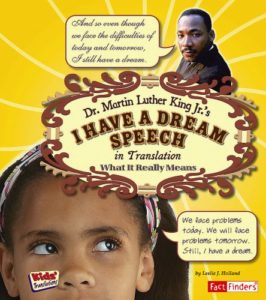
Dr. Martin Luther King, Jr.’s I Have a Dream Speech in Translation
By Leslie J. Holland
This book presents Dr. King’s speech and explains its meaning using everyday language. It describes the events that led to the speech and its significance through history. 8-10 years

The March on Washington:
A Primary Source Exploration of the Pivotal Protest
By Heather E. Schwartz
The March on Washington brought 200,000 people together. They spoke of equality for people of all races. They spoke of a dream for a better future. In this book, explore the points of views of the people who led the March on Washington and the people who opposed them through powerful primary sources and historical photos. 8-10 years
The book descriptions used are primarily from the publishers.
If you like this post, then please consider sharing it and leaving a comment below. Thank you! Barbara Lowell, Children’s Author
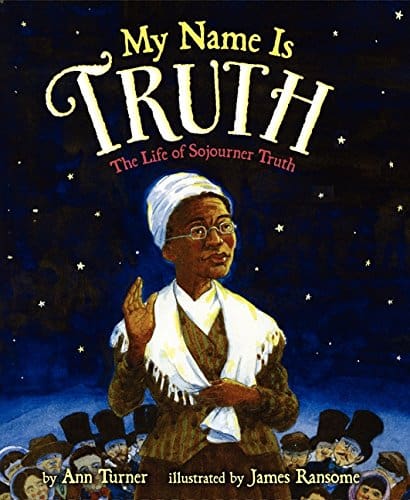
My Name is Truth: The Story of Sojourner Truth
By Ann Turner, Illustrated by James Ransome
This book tells the remarkable story of how former slave Isabella Baumfree transformed herself into the preacher and orator Sojourner Truth. She was an iconic figure of the abolitionist and women’s rights movements. 6-10 years

So Tall Within: Sojourner Truth’s Long Walk Toward Freedom
By Gary D. Schmidt, Illustrated by Daniel Minter
Sojourner Truth was born into slavery but possessed a mind and a vision that knew no bounds. So Tall Within traces her life from her painful childhood through her remarkable emancipation to her incredible leadership in the movement for rights for both women and African Americans. 4-8 years
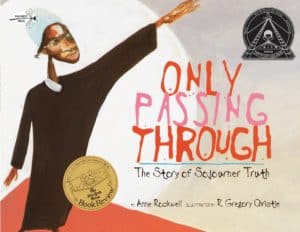
Only Passing Through: The Story of Sojourner Truth
By Anne Rockwell, Illustrated by R. Gregory Christie
Sojourner Truth traveled the country in the latter half of the 19th century speaking out against slavery and telling her story. She was sold three times by age 13, beaten for not understanding her master’s orders, and watched her parents die of cold and hunger when they could no longer work. Sojourner’s simple yet powerful words helped people understand the truth about slavery. 6-9 years
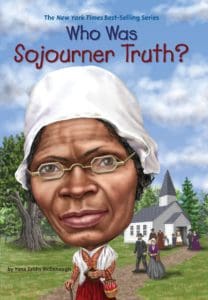
Who Was Sojourner Truth?
By Yona Zeldis McDonough, Illustrated by Jim Eldridge
Almost 100 years before Rosa Parks refused to give up her bus seat, Sojourner Truth was mistreated by a streetcar conductor. She took him to court and won her case. Born a slave in New York around 1797, she was later sold and separated from her family. Even after she escaped from slavery, she knew her work was not done. She changed her name from Belle to Sojourner and traveled around America sharing her story until her death at age 86. 8-12 years

Sojourner Truth’s Step-Stomp Stride
By Andrea Davis Pinkney, Illustrated by Brian Pinkney
Born into slavery, Belle had to endure the cruelty of several masters before she escaped to freedom. But she knew she wouldn’t really be free unless she helped to end the injustice of slavery. That’s when she changed her name to Sojourner Truth and traveled across the country demanding equal rights for African Americans and women. Many people weren’t ready for her message, but she was brave and her truth powerful. And slowly, but surely as her step-stomp stride, Americans began to change. 5-9 years
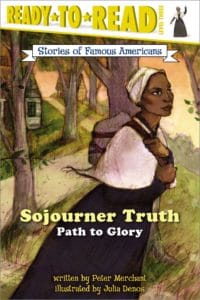
Sojourner Truth: Path to Glory
By Peter Merchant, Illustrated by Julia Denos
Sojourner Truth had a difficult childhood. She was born a slave and many of the families she worked from treated her poorly. But when she escaped from slavery, she used her life to teach others about the power of freedom. Level 3 reader, 6-8 years
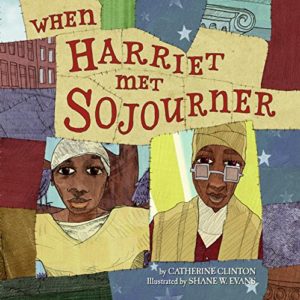
When Harriet Met Sojourner
By Catherine Clinton, Illustrated by Shane W. Evans
This book is about two women with similar backgrounds. Both were slaves, both were fiercely independent, and both were great in different ways. Harriet Tubman was a brave pioneer who led her fellow slaves to freedom. Sojourner Truth was a strong woman who spoke up for African American rights. One day in 1864, they met. This is a portrait of two remarkable women, from their inauspicious beginnings to their pivotal roles in the battle for America’s future. 4-8 years

Sojourner Truth: Fighting for Freedom
By Jeri Cipriano, Illustrated by Scott R. Brooks
Sojourner Truth was born to slaves. She had no choice. But when she grew to be a young mother herself, she ran away with her child looking for freedom. She used her voice to speak for all slaves wanting to be free. 5-8 years
The book descriptions are primarily from the publishers.
If you like this post, then please consider sharing it and leaving a comment below. Thank you! Barbara Lowell, Children’s Author

Rosa
By Nikki Giovanni, Illustrated by Bryan Collier
Over sixty years after her refusal to give up her seat on a Montgomery, Alabama city bus, Rosa Parks is still one of the most important figures in the American civil rights movement. This book is a tribute to her courageous action and the events that followed.
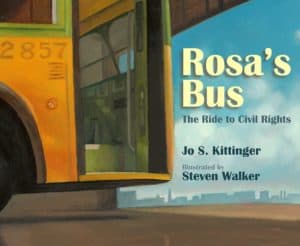
Rosa’s Bus: The Ride to Civil Rights
By Jo S. Kittinger, Illustrated by Steven Walker
Like all buses in Montgomery, Alabama in the 1950s, Bus Number 2857 was segregated. White passengers sat in the front and black passengers sat in the back. That is until Rosa Parks refused to give up her seat to a white passenger. Her arrest sparked the Montgomery Bus Boycott, a major event in the Civil Rights movement. It was led by the young minister, Dr. Martin Luther King, Jr. For 382 days, black passengers walked instead of riding the bus.

A Girl Named Rosa: The True Story of Rosa Parks
By Denise Lewis Patrick, Illustrated by Melissa Manwill
The “A Girl Named” series tells the stories of how ordinary American girls grew up to be extraordinary women. Rosa Parks refused to give up her bus seat to a white passenger in 1955. How did she come to be so brave? Learn the defining moments in her childhood and adolescence that led to her bravery.

It’s Her Story: Rosa Parks
By Lauren Burke, Illustrated by Shane Clester
A graphic novel for children ages 6 to 9. Rosa Parks was the courageous thinker and leader known as the Mother of the Civil Rights Movement. Long before the Montgomery Bus Boycott made her famous, she was a social justice activist and organizer. In honor of her work, she received a Congressional Gold Medal and the Presidential Medal of Freedom. This is her story.

Who Was Rosa Parks?
By Yona Zeldis McDonough, Illustrated by Stephen Marchesi
In 1955, Rosa Parks refused to give her bus seat to a white passenger in Montgomery, Alabama. This seemingly small act triggered civil rights protests across America and earned her the title “Mother of the Civil Rights Movement.”

Back of the Bus
By Aaron Reynolds, Illustrated by Floyd Cooper
A boy and his mother are riding the bus in Montgomery, Alabama like any other day, way in the back of the bus. The boy passes time by watching his marble roll up and down the aisle with the motion of the bus…until a big commotion breaks out from way up front. With simple words and powerful illustrations, this story recounts the pivotal arrest of Rosa Parks at the dawn of the Civil Rights Movement.
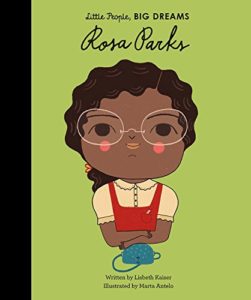
Rosa Parks (Little Leaders)
By Lisabeth Kaiser, Illustrated by Marta Antelo
Rosa Parks grew up in Alabama, where she learned to stand up for herself at an early age. Rosa went on to become a civil rights activist. In 1955, she refused to give up her seat to a white man on a segregated bus, sparking the Montgomery Bus Boycott. Her courageous decision had a huge impact on civil rights, eventually leading to the end of segregation on public transport. She never stopped working for equal rights. This book includes a biographical timeline with historical photos and a detailed profile of the activist’s life.
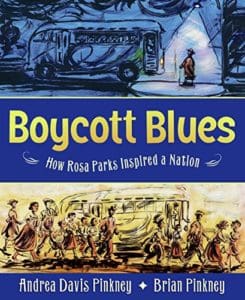
Boycott Blues: How Rosa Parks Inspired a Nation
By Andrea Davis Pinkney, Illustrated by Brian Pinkney
Rosa Parks took a stand by keeping her seat in the front of the bus. When she was arrested, her supporters protested by refusing to ride. After 382 days of walking, they walked Jim Crow right out of Montgomery, Alabama.
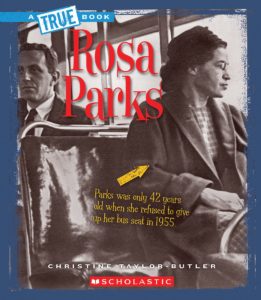
Rosa Parks (A True Book)
By Christine Taylor-Butler
On December 1, 1955, Rosa Parks was arrested when she refused to give up her seat on a bus to a white man. Almost overnight, she became an icon of the rapidly growing civil rights movement. Young readers will learn how she continued to fight for civil rights after her arrest.

Rosa Parks/National Geographic Kids
By Kitson Jazynka
Find out about the life of Rosa Parks and how her actions in Montgomery, Alabama, in 1955, helped end racial segregation in America. Her life story has enduring lessons to teach young readers.
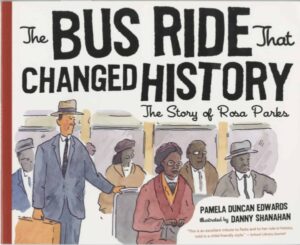
The Bus Ride That Changed History: The Story of Rosa Parks
By Pamela Duncan Edwards, Illustrated by Danny Shanahan
In 1955, a young woman named Rosa Parks took a big step for civil rights when she refused to give up her seat on a bus for a white passenger. The bus driver told her to move. Jim Crow laws told her to move. But Rosa Parks stayed where she was, and a chain of events was set into motion that would eventually change the course of American history. 4-7 years
The book descriptions used are primarily from the publishers.
If you like this post, then please consider sharing it and leaving a comment below. Thank you! Barbara Lowell, Children’s Author











































































































